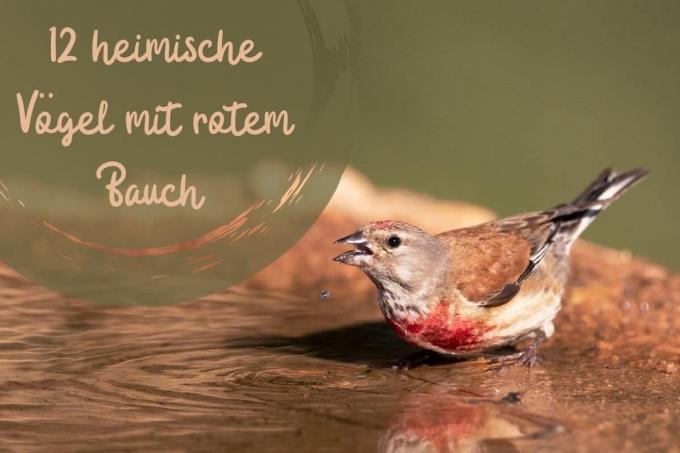
table of contents
- Types from A - E
- Types from F - J
- Types of K - R
- Types from S - Z
- frequently asked Questions
The bird world is colorful. Only butterflies and fish can come up with a greater variety of colors. Domestic red-bellied birds are especially popular. We introduce twelve of them.
In a nutshell
- more than 500 bird species are native to Germany
- a red head or belly in males increases the success in finding a partner
- Species with a red belly are particularly popular with humans
- Colors in the plumage are created by pigments and structural colors
Types from A - E
Linaria cannabina

- Size: 12 to 14 centimeters
- Male appearance: red chest, brown back, gray head, red forehead
- Appearance of the female: sparrow-like, without red parts
- singing: nasal, pressed
- Distribution: not nationwide in Germany, lives on bushy slopes, in parks, in cemeteries
- Diet: almost exclusively plant seeds, rarely insects
- Other names: flax finch
- Feature: partial puller
Note: The bloodlines are on the red list. It is endangered in Germany
Chaffinch (Fringilla coelebs)

- Size: 14 to 18 centimeters
- Appearance of the male: belly and head sides red-brown to brown-pink, crown blue-gray, back brown, forehead black, beak steel-blue in spring, otherwise horn-colored, white shoulder spot
- Appearance of the female: overall lighter than the male, back olive-gray, beak light brown
- Singing: very distinctive
- Distribution: all over Germany in forests, parks and gardens
- Diet: insects, spiders, berries, seeds
- Other names: Edelfink
- Feature: standing bird
By the way, bird watchers remember the typical song of the chaffinch with the donkey bridge "I-write-to-the-government".
Kingfisher (Alcedo atthis)
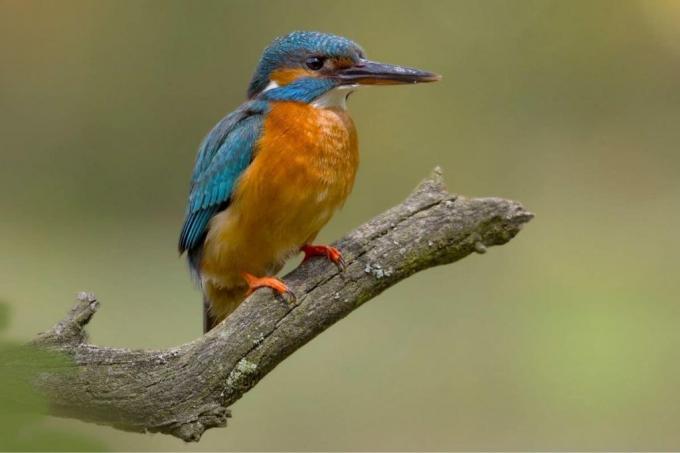
- Size: 17 to 19.5 centimeters
- Male appearance: compact body, short legs, iridescent blue plumage, orange-red belly
- Appearance of the female: same color as the male, differentiated by the red underside of the beak
- Singing: sharp whistling call, singing simple
- Distribution: not nationwide in Germany, lives near flowing water
- Diet: small fish, frogs, tadpoles and insects
- Other names: king fisher
- Feature: standing bird
By the way, kingfisher pairs can raise up to 21 young a year. In order for this to happen, the male takes care of the young while the female is already hatching a new clutch.
Types from F - J
Crossbill (Loxia curvirostra)

- Size: 15 to 17 centimeters
- Appearance of the male: compact body, strong crossed beak, wings and tail dark brown, red head, red belly, red rump
- Appearance of the female: olive-green with a yellow rump, otherwise similar to the male
- Singing: varied, nasal, purring, call "gip-gip-gip"
- Distribution: Widespread in Germany in coniferous forests
- Food: seeds of spruce and other conifers, flower buds, small insects
- Other names: Scots Parrot
- Characteristic: not a migratory bird, but a migratory bird that migrates to where there is enough food
Common redstart (Phoenicurus phoenicurus)

- Size: 13 to 14 centimeters
- Appearance of the male: slim body, red tail, red belly, black cheeks, black throat, white headband
- Appearance of the female: chest beige-white to light orange, back gray
- Singing: smacking
- Distribution: in Germany in varied landscapes, on orchards
- Diet: insects, spiders, worms, berries
- Other names: wood redstart
- Feature: standing bird
Bullfinch (Pyrrhula pyrrhula)
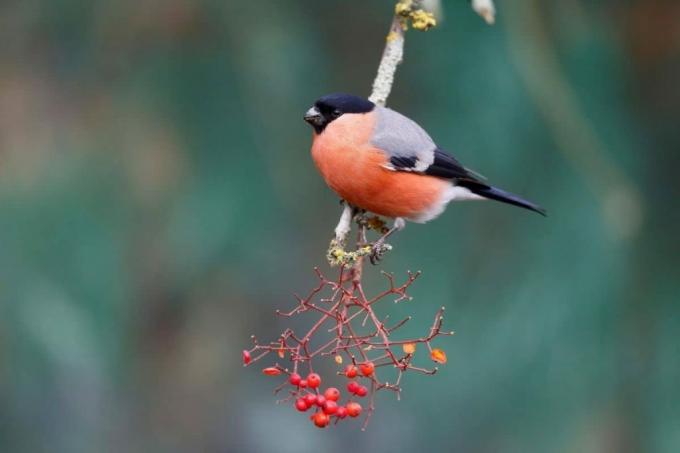
- Size: 13 to 14 centimeters
- Appearance of the male: strong stature, red breast, black cap, thick black beak
- Appearance of the female: chest gray-brown, back gray
- Singing: soft with whistling elements
- Distribution: all over Germany in forests, parks and gardens
- Food: adult birds only eat seeds, young birds eat insects, spiders and seeds
- Other names: bullfinch, gold finch, blood finch
- Feature: standing bird
Types of K - R
Carrion Pickle (Carpodacus erythrinus)

- Size: 13 to 15 centimeters
- Appearance of the male: red head, red breast, red rump, otherwise brown-gray
- Appearance of the female: plain brown-gray with black dashes
- Singing: fluting, rhythmic, call whistling
- Distribution: mainly in Mecklenburg-Western Pomerania, in fields, in forests and parks
- Food: seeds, buds
- Other names: unknown
- Characteristic: migratory bird
Rust goose (Tadorna ferruginea)
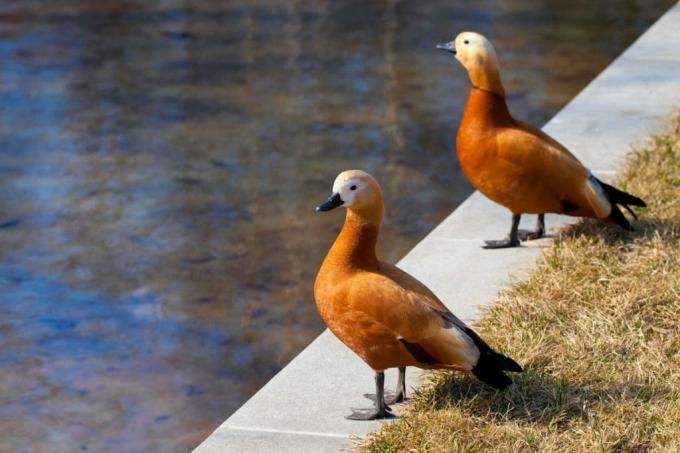
- Size: 58 to 70 centimeters
- Appearance of the male: small goose with rust-red plumage, light-colored head, black neck ring
- Appearance of the female: similar to the male, face slightly lighter
- Singing: trumpeting calls
- Distribution: sporadically in Germany on lakes and ponds
- Food: small fish, frogs, worms, insects, grasses, seeds
- Other names: unknown
- Feature: partial puller
Red necked goose (Branta ruficollis)
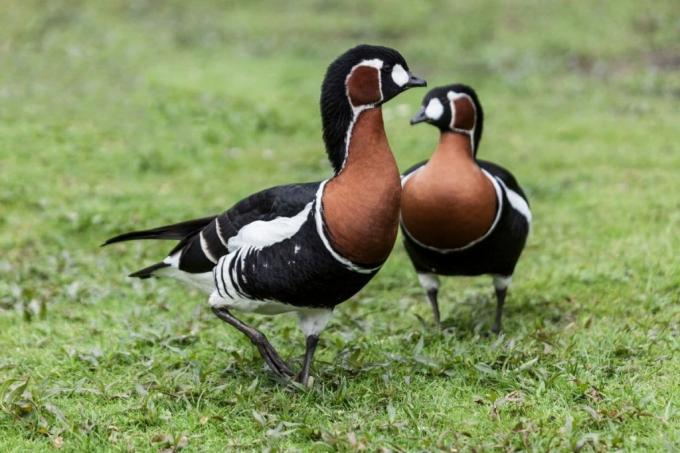
- Size: 55 centimeters
- Appearance of the male: compact body, strong neck, small beak, rust-red chest, rust-red Throat, sides of the head red, black plumage on the back and belly. Appearance of the female: similar to that male
- Singing: shrill staccato calls
- Distribution: sporadically in Germany on lakes and ponds
- Food: grass, samphire, insects
- Other names: unknown
- Characteristic: migratory bird
European robin (Erithacus rubecula)

- Size: 13 to 14 centimeters
- Appearance of the male: orange-red color from the front forehead over the throat to the chest, sides of the head red, upper side olive-brown to gray, underside white, feet dark brown, beak black
- Appearance of the female: like the male
- Singing: powerful, fast zik sounds, sparkling singing
- Distribution: distributed all over Germany in deciduous and mixed forests with dense undergrowth
- Food: insects, spiders, worms, caterpillars, nuts and berries in winter
- Other names: Rötele, Rotbrüstle
- Feature: standing bird
Types from S - Z
Stonechat (Saxicola rubicola)

- Size: 12 to 13 centimeters
- Appearance of the male: black head, white neck ring, red breast, dark beak, plain winter dress after moulting
- Appearance of the female: slightly lighter than the male
- Singing: whistling with smacking sounds
- Distribution: mainly in the east, south and west of Germany on open areas, raised bogs and heaths
- Food: insects, spiders, worms
- Other names: unknown
- Feature: partial puller
Red chalk (Monticola saxatilis)
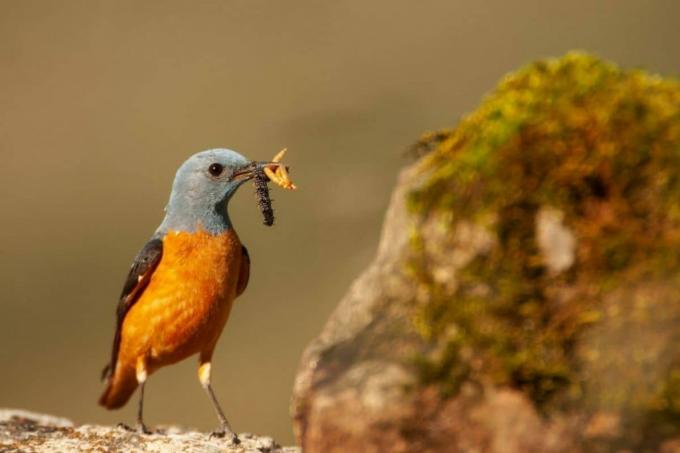
- Size: 18 to 19 centimeters
- Appearance of the male: short-tailed thrush with a small beak, head and plumage blue-gray, belly and chest rust-red, white back when in flight
- Appearance of the female: brown, light throat and red-brown tail
- Singing: soft flute
- Distribution: in Germany almost only in the Allgäu mountains, endangered
- Diet: insects, spiders, worms, small reptiles, berries
- Other names: Berglerche
- Characteristic: migratory bird
frequently asked Questions
Embedded pigments produce the bright colors of the bird's feathers. Carotenoids that are ingested with food produce red, orange and pink tones in the plumage.
The uneven color distribution has to do with the mating behavior of the birds. Every bird wants to have healthy offspring. Beauty is seen as a sign of health. The male birds have to compete for the favor of the females. A red head or belly makes the male bird interesting for the female.
Birds, reptiles and fish are able to perceive a wider range of colors than humans. They use four types of color receptors to recognize colors.
